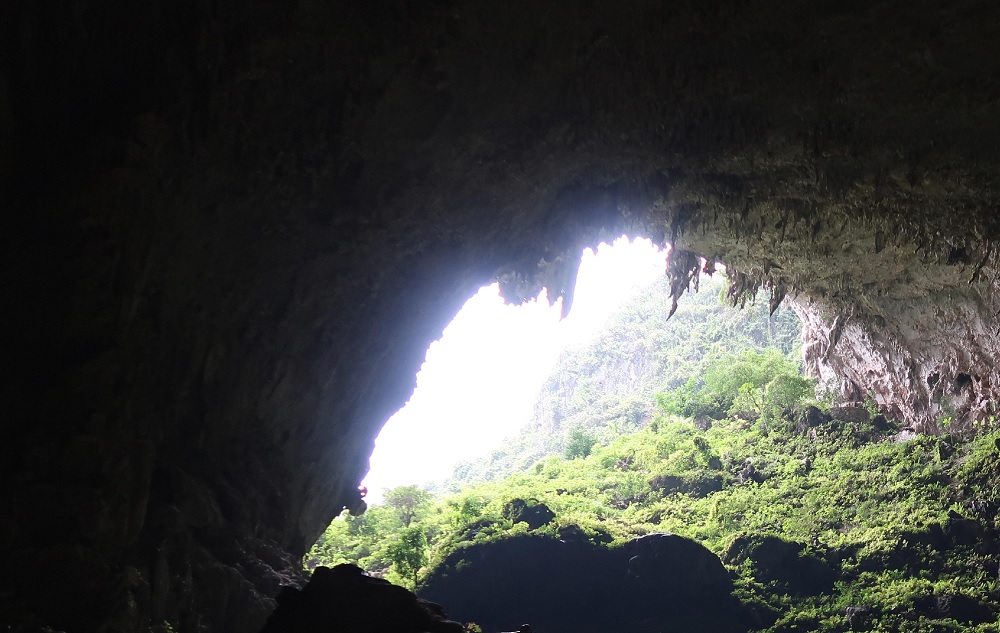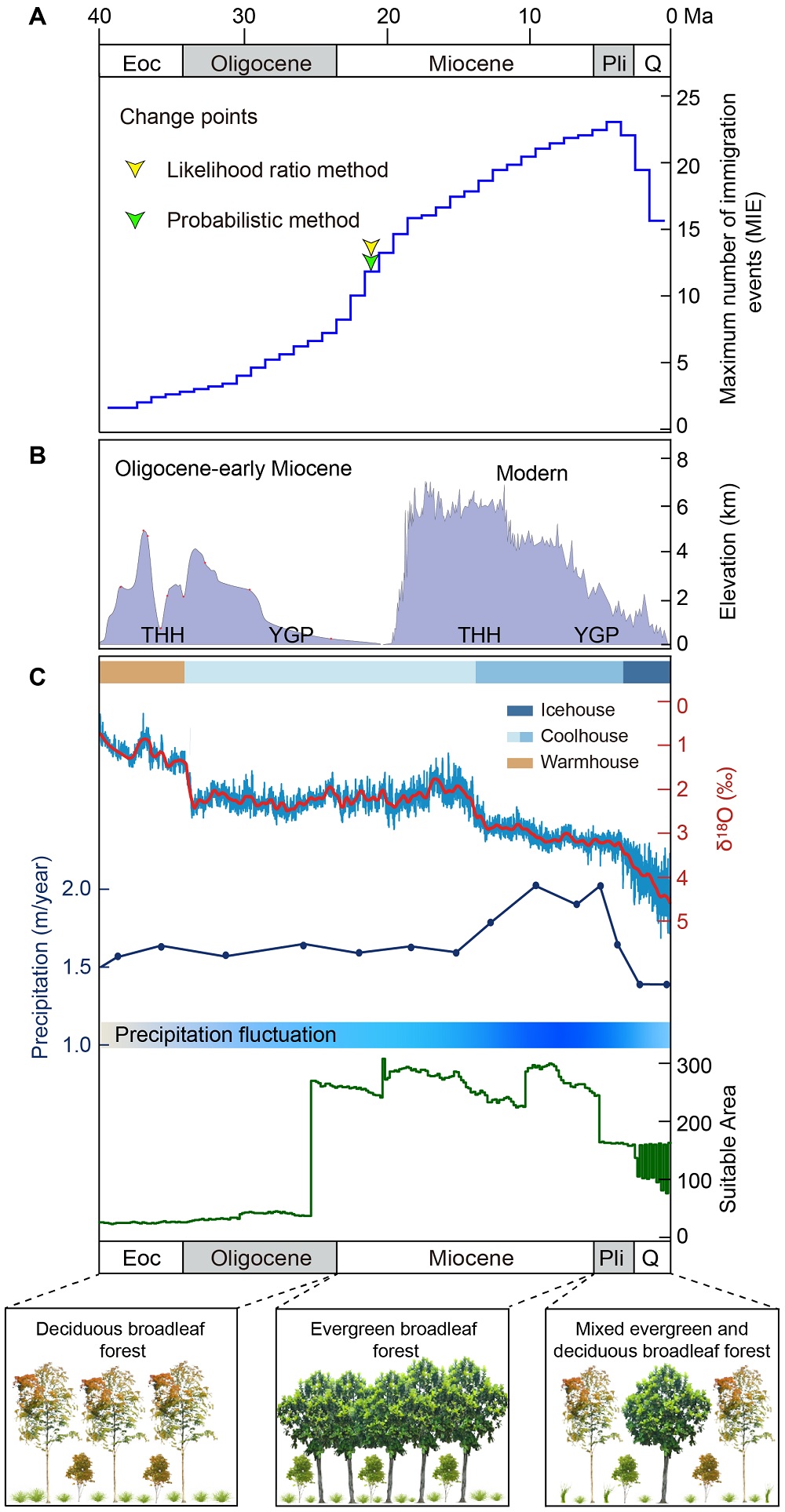Caves are formed by chemical reactions between circulating groundwater and surrounding rocks and have an isolated and strongly zonal environment, characterized by dim light, oligotrophy, and low diurnal and annual variation in temperature and humidity. They are home to unique and fragile biotas with high levels of endemism. However, little is known about how the biotic colonization of caves has developed over time, especially in caves from middle and low latitudes.
Subtropical East Asia holds the world's largest karst landform with numerous ancient caves, which harbor a high diversity of cave-dwelling organisms and are regarded as a biodiversity hotspot. A research group led by Prof. WANG Wei from the Institute of Botany of the Chinese Academy of Sciences (IBCAS) selected 28 clades with 1437 species, belonging to 43 genera representing seven major clades of life (ferns, angiosperms, arachnids, amphibians, reptiles, fishes, and fungi), to unravel the colonization history of subtropical East Asian caves.
The researchers found that most cave colonization events occurred after the Oligocene-Miocene boundary and that the surrounding forest was a major source for cave biodiversity. Biotic colonization during the Neogene was not a random process, but was subject to periods of acceleration and decrease. By modeling the variation of suitable area of East Asian subtropical evergreen broad-leaf forests over time and analyzing paleoclimate data from 19 fossil sites, they further proposed that biotic colonization of subtropical East Asian caves during the Neogene was in conjunction with large-scale, seasonal climatic changes and evolution of local forests.
The researchers provide insights into how subterranean biodiversity is shaped over time. They discover that the climate changes over time and the evolution of local vegetation, as well as the establishment of seasonal climate, drove the biotic colonization of subtropical East Asian caves over time. They further proposed the climate-vegetation-relict model for the subtropical East Asian cave biota, which may also help explain the evolutionary origins of other mid-latitude subterranean biotas. Moreover, they document that cave biotas may be the extensions of the local surface biotas. Additionally, they also identified nine transitions from caves back to the surface environment.
"This study will improve our understanding of evolutionary processes of adaptation to unique habitats and contribute to interdisciplinary integration, and highlights the long-term evolutionary interaction between surface and cave biotas, which will be of particular importance for biodiversity conservation planning since globally, most caves do not fall within protected areas," said Prof. WANG Wei, correspondence author of the study.
The above study has been published online in PNAS.

An example of karst caves, the Yangzi Cave in Guangxi, China (Image by IBCAS)

Colonization dynamics of subtropical East Asian caves in relation to paleogeoclimate and vegetation changes (Image by IBCAS)
Article Link: https://doi.org/10.1073/pnas.2207199119
Contact:
WANG Wei
Institute of Botany
E-mail: wangwei1127@ibcas.ac.cn
Caves are formed by chemical reactions between circulating groundwater and surrounding rocks and have an isolated and strongly zonal environment, characterized by dim light, oligotrophy, and low diurnal and annual variation in temperature and humidity. They are home to unique and fragile biotas with high levels of endemism. However, little is known about how the biotic colonization of caves has developed over time, especially in caves from middle and low latitudes.
Subtropical East Asia holds the world's largest karst landform with numerous ancient caves, which harbor a high diversity of cave-dwelling organisms and are regarded as a biodiversity hotspot. A research group led by Prof. WANG Wei from the Institute of Botany of the Chinese Academy of Sciences (IBCAS) selected 28 clades with 1437 species, belonging to 43 genera representing seven major clades of life (ferns, angiosperms, arachnids, amphibians, reptiles, fishes, and fungi), to unravel the colonization history of subtropical East Asian caves.
The researchers found that most cave colonization events occurred after the Oligocene-Miocene boundary and that the surrounding forest was a major source for cave biodiversity. Biotic colonization during the Neogene was not a random process, but was subject to periods of acceleration and decrease. By modeling the variation of suitable area of East Asian subtropical evergreen broad-leaf forests over time and analyzing paleoclimate data from 19 fossil sites, they further proposed that biotic colonization of subtropical East Asian caves during the Neogene was in conjunction with large-scale, seasonal climatic changes and evolution of local forests.
The researchers provide insights into how subterranean biodiversity is shaped over time. They discover that the climate changes over time and the evolution of local vegetation, as well as the establishment of seasonal climate, drove the biotic colonization of subtropical East Asian caves over time. They further proposed the climate-vegetation-relict model for the subtropical East Asian cave biota, which may also help explain the evolutionary origins of other mid-latitude subterranean biotas. Moreover, they document that cave biotas may be the extensions of the local surface biotas. Additionally, they also identified nine transitions from caves back to the surface environment.
"This study will improve our understanding of evolutionary processes of adaptation to unique habitats and contribute to interdisciplinary integration, and highlights the long-term evolutionary interaction between surface and cave biotas, which will be of particular importance for biodiversity conservation planning since globally, most caves do not fall within protected areas," said Prof. WANG Wei, correspondence author of the study.
The above study has been published online in PNAS.

An example of karst caves, the Yangzi Cave in Guangxi, China (Image by IBCAS)

Colonization dynamics of subtropical East Asian caves in relation to paleogeoclimate and vegetation changes (Image by IBCAS)
Article Link: https://doi.org/10.1073/pnas.2207199119
Contact:
WANG Wei
Institute of Botany
E-mail: wangwei1127@ibcas.ac.cn
